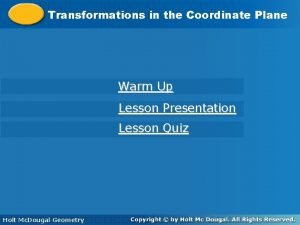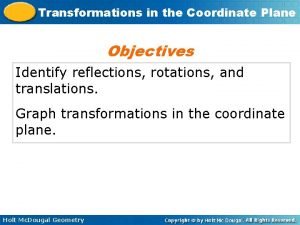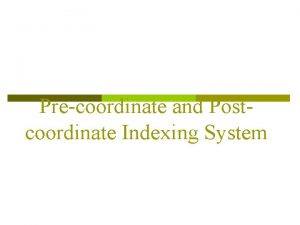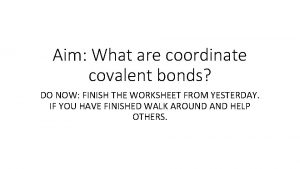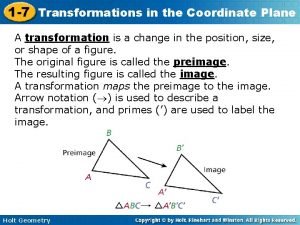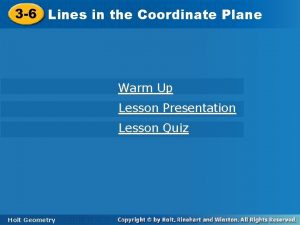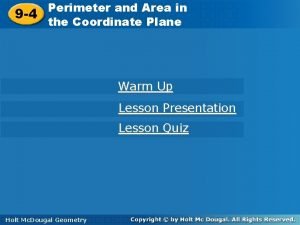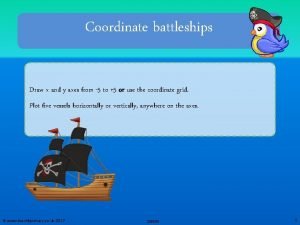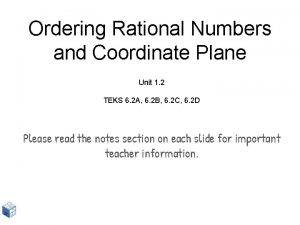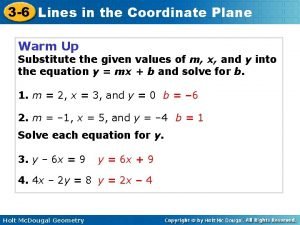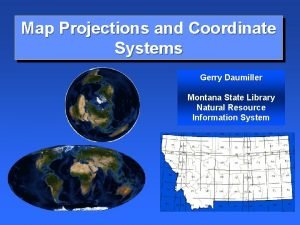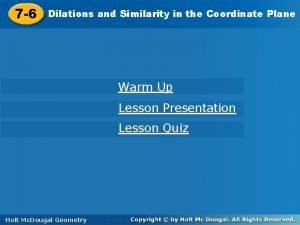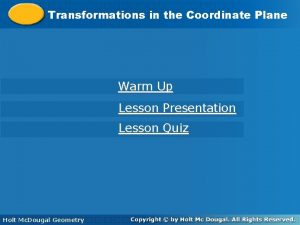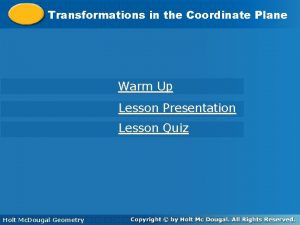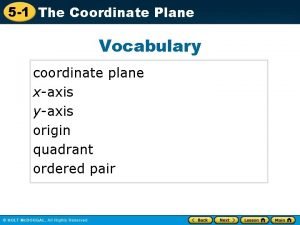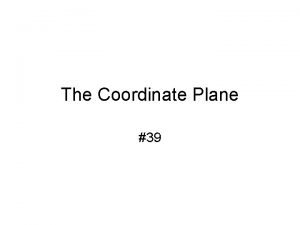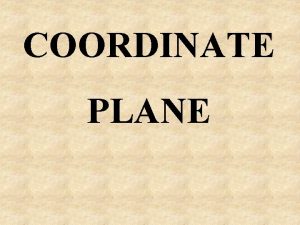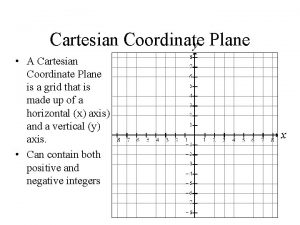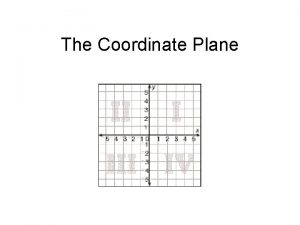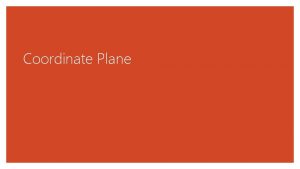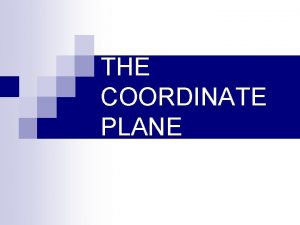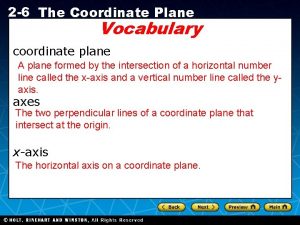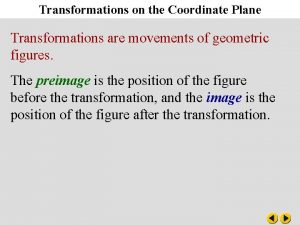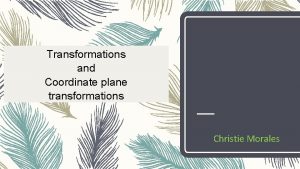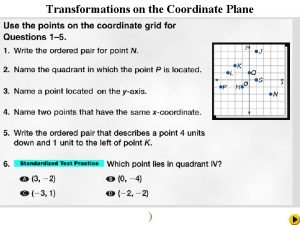Transformations on the Coordinate Plane 3 2 III
















- Slides: 16

Transformations on the Coordinate Plane (3, – 2) III Q (0, 1) J (1, 4) & S (1, 0) (– 3, – 2) )

In geometry, a transformation is a way to change the position of a figure.

REFLECTION

REFLECTION A reflection is a transformation that flips a figure across a line. A REFLECTION IS FLIPPED OVER A LINE.

REFLECTION Remember, it is the same, but After a shape itisisreflected, it looks like a backwards mirror image of itself. A REFLECTION IS FLIPPED OVER A LINE.

REFLECTION The of reflection can be onthe shape Thelinethe that a shape isexactly flipped over is Notice, shapes are same or it cana be outside theofshape. called line ofthe reflection. distance from line reflection on both sides. Line of reflection A REFLECTION IS FLIPPED OVER A LINE.

REFLECTION Sometimes, a figure has reflectional symmetry. This means that it can be folded along a line of reflection within itself so that the two halves of the figure match exactly, point by point. Basically, if you can fold a shape in half and it matches up exactly, it has reflectional symmetry.

REFLECTIONAL SYMMETRY An easy way to understand reflectional symmetry is to think about folding. Do you remember What happens when folding a piece of you unfold the piece paper, ofdrawing paper? half of a heart, and then cutting it out?

REFLECTIONAL SYMMETRY Line of Symmetry Reflectional Symmetry The line of reflection means that a shape The two halves are in a figure with can be along exactly the same… The twofolded halves makea reflectional linea whole of. They reflection are heart. so symmetry is called a the symmetrical. two haves of the line of symmetry. figure match exactly, point by point.

REFLECTIONAL SYMMETRY The line created by the fold is the line of symmetry. How can I fold thiscan shape somore than one line of symmetry. A shape have that it matches Where is the line of symmetry for this shape? exactly? I CAN THIS WAY Line of Symmetry NOT THIS WAY

REFLECTIONAL SYMMETRY How many lines of symmetry does each shape have? Do you see a pattern?

REFLECTIONAL SYMMETRY Which of these flags have reflectional symmetry? United States of America Canada Mexico England

Reflections on a Coordinate Plane • Performing reflections on a coordinate plane. • The x-axis and y-axis will be our lines of reflections. • You have to count the spaces on the coordinate plane in order to determine the distance between a point and the line of reflection.

Example #1: Reflect the object below over the x-axis: Name the coordinates of the original object: A: (-5, 8) A B: (-6, 2) C: (6, 5) D D: (-2, 4) Name the coordinates of the reflected object: A’: B’: C’: D’: (-5, -8) (-6, -2) (6, -5) (-2, -4) C B B’ D’ A’ How were the coordinates affected when the object was reflected over the x-axis? C’

Example #2: Reflect the object below over the y-axis: Name the coordinates of the original object: T: (9, 8) T T’ J: (9, 3) Y: (1, 1) Name the coordinates of the reflected object: T’: (-9, 8) J’ J Y’ Y J’: (-9, 3) Y’: (-1, 1) How were the coordinates affected when the object was reflected over the y-axis?

Example #3: Reflect the object below over the x-axis and then the y-axis: Name the coordinates of the original object: R: (-9, 9) R P: (-8, 5) P D: (-2, 4) U: (-9, 2) Name the coordinates of the reflected object: R’’: (9, -9) U D Would it make a difference if we reflected over the yaxis first and then the x-axis? Try it! Then reflect about what you discovered. U’ U’’ P’’: (8, -5) D’ D’’: (2, -4) P’ P’’ U’’: (9, -2) R’ How were the coordinates affected when the object was reflected over both the x-axis and y-axis? R’’
 Transformation in coordinate plane
Transformation in coordinate plane 90 degree clockwise rotation
90 degree clockwise rotation Transformations in the coordinate plane
Transformations in the coordinate plane Software-defined networking: a comprehensive survey
Software-defined networking: a comprehensive survey Post coordinate indexing example
Post coordinate indexing example Is c-o a covalent bond
Is c-o a covalent bond Hamlet act iii scene ii
Hamlet act iii scene ii 1-7 transformations in the plane answer key
1-7 transformations in the plane answer key 3-6 lines in the coordinate plane
3-6 lines in the coordinate plane 9-4 perimeter and area in the coordinate plane
9-4 perimeter and area in the coordinate plane Coordinate plane battleship
Coordinate plane battleship George wrote an integer
George wrote an integer River riding coordinate plane
River riding coordinate plane 3-6 lines in the coordinate plane
3-6 lines in the coordinate plane Utm zones virginia
Utm zones virginia Lambert projection
Lambert projection Dilations and similarity in the coordinate plane
Dilations and similarity in the coordinate plane
